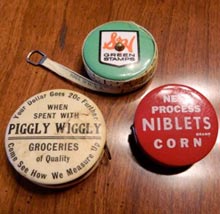 Cora started collecting when she inherited her Grandmother’s collections in the early 1980’s. Her grandmother had married and moved out west for many years. Eventually they moved to pan handle of Florida to open a dairy, which they ran through the Depression. She had a hardworking life, but like many women of her time, she collected beautiful things. Her collections included thimbles and tape measures.
Cora started collecting when she inherited her Grandmother’s collections in the early 1980’s. Her grandmother had married and moved out west for many years. Eventually they moved to pan handle of Florida to open a dairy, which they ran through the Depression. She had a hardworking life, but like many women of her time, she collected beautiful things. Her collections included thimbles and tape measures.
Collecting tape measures was a popular pastime in the 1950‘s and 1960‘s. They were so popular they were often given as premiums with household goods or as advertising gifts. As advertising became more sophisticated the “free gifts with purchase” became less common (unless you were buying children’s cereal). Now collectors enjoy finding things that were given out when they were younger, and items such as Depression glasses and measuring tapes are quite sought after.
Tapes are harder to find than they used to be. Since they were utilitarian items many didn’t survive long. Now Cora watches online auctions such as Ebay and scans the aisles at antique shops. Another good source, according to Cora, is the online antique store Ruby Lane.
Collecting Figural Tape Measures by Elizabeth and Douglas Arbittier and Janet and John Morphy (and published by Schiffer Books) is a great guide for collectors. The book features tapes representing many categories. Figural tapes and those with vintage advertising are the most highly collected and therefore the most valuable. Of course, popular subjects bring higher values than tho se in the same category but of less exciting subjects. Cora favors Piggly Wiggly store advertising and grocery items because her father managed one of the chain’s stores for many years and because they represent the material culture of her youth. Once she spotted a group of tapes for auction on Ebay. She wasn’t interested in most of them, but there was a Piggly Wiggly tape in the group. She contacted the owner of the collection about buying only that one piece. He was unwilling to break up the group, but asked “What in the world would you want that for?”
se in the same category but of less exciting subjects. Cora favors Piggly Wiggly store advertising and grocery items because her father managed one of the chain’s stores for many years and because they represent the material culture of her youth. Once she spotted a group of tapes for auction on Ebay. She wasn’t interested in most of them, but there was a Piggly Wiggly tape in the group. She contacted the owner of the collection about buying only that one piece. He was unwilling to break up the group, but asked “What in the world would you want that for?”
Early tape measures were primitive tapes used in Egypt, but standardization of measurements didn’t occur the 12th century when Henry I of England used his own arm length to introduce the 36” yard. English merchants began to use yard long lengths of ribbon or string to measure all sorts of goods and the practice traveled across Europe. By the mid-19th century there was almost worldwide standardization. Early cased tapes were usually in metal, but by the 1920s there were a wide variety of materials and shapes used for cases.
Rarities in Cora’s collection include an alligator and a tape marked “Bundles for Britain,” which was to bring the need for donation of goods for bombed out citizens of London during World War II. Another rare item that both she and I favored is a tape in the shape of a man’s head. The end of the measure is capped with a fly that sits atop the man’s pate.
Cora’s dream finds are figural tapes and those in the shape of antique cars. Of course, part of her dream is to find pieces in these popular categories at bargain prices. Her advice to beginning collectors is to start your collection with a particular type such as advertising pieces or utilitarian themes. As with all collecting, buy the best you can afford and avoid buying common pieces in poor condition.
Libby Holloway is a Certified Appraiser of antiques and residential contents. She is a member of the International Society of Appraisers where she is currently serving as Secretary of the Board of Directors. She is also a partner at Antiques and Such in Beaufort, SC. Libby can be contacted at www.LibbyHollowayAppraisals.com






